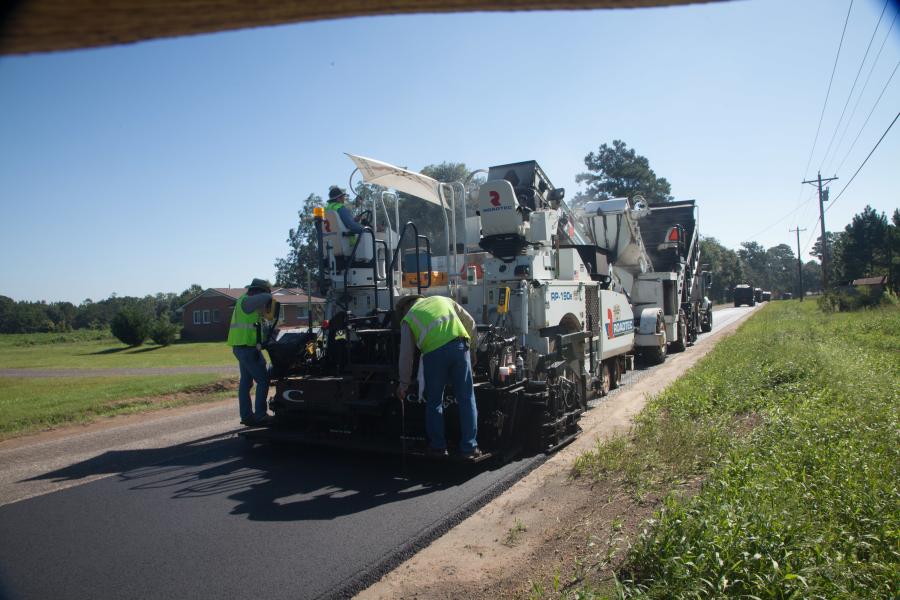Peavy and Son Construction used its highway-class Roadtec RX-900e cold planer to mill a full 3.25 in. (8.25 cm) depth.
The Peavy and Son Construction I-10 work received FDOT’s “Smoothest Pavement of the Year Award” in the Limited Access Roadway category for 2014.
There were no completed sections of I-10 until 1961 when the nearly 37-mi. (59.5 km) Sanderson to Jacksonville stretch was first finished. In the years since, section by section have been constructed, culminating in the complete stretch of I-10 in Florida that spans the top of the state 362-mi. (582.5 km) from the western reaches of the panhandle to downtown Jacksonville, where it is punctuated with an “End I-10” sign.
The interstate stretches west well beyond the Florida border making I-10 one of three coast-to-coast interstates, along with I-80 and I-90. In 2015, the Florida Department of Transportation (FDOT) awarded the complete rehab of an 8-mi. (12.9 km) section of I-10 falling between Tallahassee and Monticello, Fla. The traffic load has steadily increased over the years.
“We won the bid and were responsible for full-depth milling and paving,” said Ensworth Blyden, estimator/project manager of Peavy and Son Construction Co., Havana, Fla. “The road was in pretty bad shape since it had last been worked on a good 12 to 15 years ago.”
Established in 1963, Peavy and Son Construction has 100-plus employees, annual revenues of approximately $20 million and specializes in site prep excavation and grading, and milling and asphalt paving. The contractor assigned a crew of five to work on the I-10 project.
Peavy and Son Construction had a 120-day deadline to complete the project. In addition to the poor road condition, the contractor had the challenge of working on a well-traveled road with hills, curves and elevations.
“We also discovered before we started milling that the road had irregularities in its width of as much as six inches,” Blyden said. “The previous contractor kept it tight on the inside road edge but the outside shoulder edge wandered.”
Blyden checked with FDOT to see if they should follow the existing road irregularities or correct it and provide a consistent finished edge. FDOT opted for the corrected road width.
Peavy and Son Construction used its highway-class Roadtec RX-900e cold planer to mill a full 3.25 in. (8.25 cm) depth. The company owns two other smaller milling machines but as Blyden said, “The RX-900e, with its 950 hp engine and heavy-duty construction, was the logical choice for tackling the rough surface and width irregularities.”
A total of 189,000 sq. yds. (158,028 sq m) of milled material was trucked out with most being converted to RAP (reclaimed asphalt pavement).
Three lifts of hot-mix asphalt (HMA) were placed using a Roadtec RP-190e rubber-tired paver designed for highway work. The paver is equipped with a Carlson EZIV rear mount screed.
Two lifts of structural asphalt were placed with a finishing friction course on top. The first structural asphalt course was 5,000 tons (4,535 km) of Traffic Level B HMA with no polymers. Then, 28,000 tons of Traffic Level D HMA with polymers was placed. A final 8,000 tons of FC-5 open-graded friction course HMA provided the final traffic surface.
HMA traffic levels are graded A through E based on the design life of the pavement where Level A equals low traffic and Level E equals high traffic. The grading is based on the rate of pavement deterioration from the estimated number of 18,000 lb. (18 kip) equivalent single-axle loads (ESALs). For any time period, ESALs on the most heavily traveled lane of the road are estimated using:
• Total traffic for a time period;
• Percentages of single unit trucks and combination trucks on the road;
• An 18-kip equivalent load factor; and
• A lane-load adjustment factor.
Choosing the right HMA is designed to ensure the longest life of a road before maintenance is required.
“At each step we have the equipment and crew to give us maximum control for the best results,” said Blyden. “Plus, we use a MTV [material transfer vehicle] to ensure that our paver is receiving HMA that is thoroughly mixed and at the right temperature.”
Peavy and Son Construction has its own Astec HMA production plant, which is located approximately 20 mi. from the job site. The company relied on its Roadtec MTV-1000 material transfer vehicle, which is designed for transferring while re-blending paving material to allow for continuous in-line paving.
“We finished the I-10 rehab project before the 120 day deadline and are very happy with the results,” Blyden said. “FDOT conducted laser profile measurements and the road's smoothness and rideability were dead on.”
In terms of quality of smoothness, the finished road received an average IRI (International Roughness Index) score of 32, which is well below the max rating of 48 assigned by the state. The quality of the road earned a 3 percent bonus plus additional incentive pay.
The contractor and its FDOT inspector weren't the only ones pleased with the quality of the completed road. The road won a prestigious award.
The Peavy and Son Construction I-10 work received FDOT's “Smoothest Pavement of the Year Award” in the Limited Access Roadway category for 2014. Annually FDOT considers all the roadwork completed in the entire state for the year and awards a winner and a runner up based on finished quality for two categories of roads, Primary Roadway and Limited Access Roadway.
“We're very happy to win the 2015 FDOT Smoothest Pavement of the Year Award for projects completed in 2014 — it's nice to be recognized,” Blyden said. “I'm proud of our crew. The road is not only a comfortable ride; it's a gorgeous piece of workmanship.”
Today's top stories














